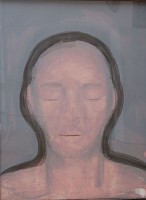BIOGRAPHY

THEA SOGGOT
Soggot was born in Johannesburg. During her Fine Art degree at the University of the Witwatersrand, she was awarded the Henri Lidchi prize for drawing in 1978 and 1979. After completing her degree, Soggot was employed as a graphic designer while also working on commissions and continuing her art practice. In the early 90s, Soggot taught at the Johannesburg Art Gallery and was a member of the Market Gallery Advisory Board. From 1992-1993, she spent eight months in the XXX Internationale des Arts. On her return, she started to exhibit internationally. Since then, she has been practicing as an artist and teaching from her studio.
Thea Soggot’s most recent images are of a face. The face looks faintly African in origin, but is finally of indeterminate race. The eyes are closed. Soggot works with rich terracotta earth sourced from the Magaliesberg hills (near Johannesburg), black ink and transparent film. The film covers the entire drawing. There is a thick black line in part silhouetting the head. Over the mouth and eyes are often horizontal lines creating apertures, a sense of potential vision or breath. The film and apertures also give a sense of a masked face. The watery earth evokes weeping scars, veins. The closed eyes evoke dreaming or inward-looking. The transparent film is also suggestive of an X-ray image – both something internal and external, below the surface and masking the surface.
Soggot has been working from the same model for several years – an actor and dancer with features both strong and delicate. Although the face is usually quite masculine, it is sometimes of indeterminate gender.
Since graduating from art school, Soggot has always concerned herself with the human figure and has chosen to work in monochromatic colours. For the first fifteen years as an artist, she confined herself to charcoal and graphite and images in black and white. She started working with earth sourced from the Magaliesberg two decades ago. Only later did she start incorporating black ink and charcoal, and has stated that she did so after seeing the consequences of a veld fire – the velvety black grass and a terracotta earth road running through it.
Soggot continues to be drawn to the unpredictable quality of earth as a material – the element of chance. She draws with earth and paints with it, and indeed much of her recent work can be seen as occupying a middle-space between drawing and painting. Although she doesn’t situate herself specifically as a South African artist, the red earth distinctly evokes the Witwatersrand where she lives. But it also suggests blood and burial – the earth from which each of us has emerged and to which we will each return.
As the earth is high in iron oxide, it stains and penetrates the paper in a way unpigmented earth would not. This process has been compared with fresco painting, where the ground receives and comes to embody the pigment rather than just carry it on the surface. The colour and luminosity of the earth also give Soggot’s forms a sculptural, monumental quality. What Spanish architect Alberto Campo Baeza has said of architecture is also true of her earth painting: “Gravity builds space, light builds time, and gives reason to time … control of gravity and dialogue with light.”
There is a poise to Thea Soggot’s work, a serenity that contains a rich internal life, which is distinctly her own. Like the giant heads on Easter Island, her portraits seem to carry messages from another time and place – messages that we can begin to access only when we dwell in mutual simplicity with them.
“In this series I work with the idea of the reduction, suppression and annihilation of the individual. Each of the drawings is of a warm and alive face. A face that lives yet seems to be fading into memory. It disappears, it vanishes. The face is drawn in earth and veiled by transparent paper. Each image faces us but avoids our gaze. It becomes an object, a specimen. Hence it cannot reveal its internal world.
“The black outline reduces the individual to a shape. An unidentifiable shape. The individual becomes anonymous. The line has equal weight with the face. Metaphorically or not it is the outline of what lived.” Thea Soggot
SELECTED SOLO EXHIBITIONS
2011
Johannesburg, Everard Read, Johannesburg
2004
Johannesburg Gallery Momo
1999
Johannesburg Goodman Gallery
1997
Mont St-Martin (France) Eglise Romane de Mont-St. Martin
1996
Johannesburg Alliance Française
1995
Knokke (Belgium) On-Gallery
1994
Jamoigne (Belgium) Grange du Faing, Centre d’Art
Contemporain du Luxembourg Belge
Johannesburg Goodman Gallery
Cape Town South African Association of Arts
1989
Johannesburg Goodman Gallery
1984
Johannesburg Goodman Gallery
ART FAIRS:
2007 – 2013
Johannesburg Art Fair
2015-2016
Johannesburg Art Fair
SELECTED GROUP EXHIBITIONS:
2016
London CIRCA, Summer Show
2007-16
JohannesburgVarious group shows
2011
Johannesburg Horse, Everard Read and CIRCA
2007
Johannesburg, Everard Read
2006
Johannesburg Gallery Momo
2005
Johannesburg Gallery Momo
2003
Johannesburg Gallery Momo
1996
Tilburg (Netherlands) Galerie Resy Muijsers
1995
Johannesburg First Gallery
1994
Johannesburg Market Gallery
1981
Johannesburg Market Gallery
COLLECTIONS:
Private, local and international
Constitutional Court, South Africa
Alliance Française, South Africa
Anglo American, South Africa



